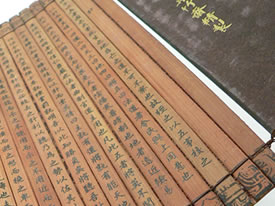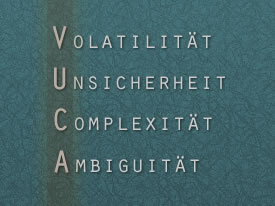8. April 2014
 »The word of VUCA sounds very VUCA, while the world of VUCA is really VUCA.«
»The word of VUCA sounds very VUCA, while the world of VUCA is really VUCA.«
That is a very interesting comment shared by one of the participants in the first TrendLab in Shanghai on February 28th, 2014.
Initiated by SYNNECTA, invited by AHK (German Chamber of Commerce), and hosted by Bosch China, the first TrendLab: 21st Century Leadership attracted more than 20 general managers and HR directors from different companies. Dr. Ruediger Muengersdorff, CEO of SYNNECTA GmbH as a chief speaker, shared different trend scenarios with the participants and moderated the rounds of discussion on leadership.
Back to the comment at the very beginning: VUCA (Volatility, Uncertainty, Complexity, Ambiguity) might be the best interpretation of the overall situation of the dynamic world: New technology is accelerating the industries; social media and IT technology connects the world more than ever; customer relationship is getting more challenging and service is much more in focus than products; Generation Y shift their needs and more and more get into management role … speed, development, change, trust are all keywords in China.
What will be the future challenges in leading companies in China? Take Generation Y as an example. Generation Y in China mostly mean the post-80’s, the generation who were born under the one-child policy, used to be the »little emperor« in a family. The need of them in a company is not to make money any more but to identify, is not to be a worker but more to be an explorer. Compared with the post-70’s, post-60’s, they have more willingness to show their opinions and need more recognition. How to find out their motivators to drive them forward, how to link them rather to the company than to the managers are the challenges for leadership. The crucial challenges for managers are how to gain more confidence and trust and how to support their employees in their development. How to motivate employees and how to find the right person for the right task? Self-steered work in projects might be an idea – if passion they have is not constant enough, achievment and responsibility are important to drive associates. Beside these, mentorship is a very hot topic which participants expected a lot to develop in companies in China.
Looking forward to the future, to developlocal decision power, to enhance China R&D, inter-culture knowledge and experience are all challenges and development trends for leadership in China.
The participants agreed that the TrendLab provoked a lot of thoughts and were keen on continuing cross-company discussions to stimulate innovation and to better prepare for the changing leadership role in the 21st century.
Vicky Qian
25. March 2014
 The wisest warrior
The wisest warrior
need not ever battle.
(Sun Tzu)
When we accompany international project or team work we often encounter a European image of China that is rather unflattering to our Asian project partner. This image depicts the Chinese as unpredictable, imprecise turncoats, as evasive and actionistic – as anything but reliable project partners with whom one can establish a stable cooperation. As is so often the case, these may be prejudices that at a closer glance prove to bear a kernel of truth: Facts that are non-judgmentally understood to reveal a different, but not necessarily wrong, behavior. In this contribution, I will investigate the hypothesis that the Chinese really do have a different strategic approach to their projects and their entire business model. Furthermore, I hypothesize that this »unreliability« is just one face of a more successful strategic approach to handling VUCA.
I want to start in a field that brought us the word »strategy« in the first place: warfare. The French philosopher and sinologist Francois Jullien has been researching the differences between European and Asian philosophies and world views for a long time. His comparison between the two war strategists Carl von Clausewitz and Sun Tzu is of utmost interest for the business world. While the Prussian military theorist wrote his classic volume On War in the 1830s, Sun Tzu formulated his hallmarks of successful military leadership as early as 500 b. C. in The Art of War. What are the differences between the European and the Chinese strategist of war?
Clausewitz was convinced that a good military leader needed a good plan that would provide an ideal basis by defining every single step from the outset all the way to the goal and result. This model assumes a chain of individual steps that follow the logic of cause and effect to eventually gain victory. Clausewitz was aware that reality can intervene and cause minor aberrations,which, however, never come to question the plan itself. He goes even further: more contrary circumstances and the need for greater heroism and bravery in faithfully executing the plan will result in a greater moment of surprise for the enemy and hence will make the plan all the more effective. The focus of the strategic plan is placed on the individual’s actions that aim for the shortest path from cause and effect: the acting subject will stick to the plan with all their might and will thus have the best chance of becoming a successful war hero.
Sun Tzu had devised a different strategic concept for success more than 2,300 years previously. His aim consisted of using the current constellation at any given moment for the benefit and profit of all. His thinking departs not from the future goal but from the given situation and the potential it bears. For Sun Tzu, strategic thinking is to define the beneficial factors of the now and to profit from them. There is no ideal plan, nor purpose-bound reasoning. Sun Tzu’s strategic leader allows an environment of favorable factors to ripen, which will eventually deliver his victory. Ideally, the situation is so well prepared at the very encounter with the enemy that the enemy will inflict failure upon himself or »is already beaten«. Thus, Sun Tzu values the easy victory that has been orchestrated out of sight. This requires the military leader to let the process run without letting go of it, having to take on a discreet secondary position and adapt to developments; Lao-tze called this »helping along that which happens by itself«. This military leader sees himself as someone who alters the situation from behind the scenes, not as someone who actively intervenes.
Strategy maps, goal cascading, milestones, annual goal agreement talks, measurement catalogs, KPI cockpits, etc: The current strategic reality of European businesses appears to reflect Clausewitz rather than Sun Tzu. I believe that a comparison of the two thinkers sheds light on how Europe culturally misunderstands Chinese project work. The Chinese partners’ lack of reliability is not due to a lack of competence: Rather, the two partners do not fit because they employ fundamentally different approaches. Europe will be well advised to take off its own, still colonialistically tinted, glasses (as Rüdiger Müngersdorff recently described so well), and to critically confront the prejudices in order to look at the situation together and at eye level with China.
I would like to go even further, however, keeping with the hypothesis outlined above: Would Europe be well advised to don Chinese glasses in order to be able to deliver better strategic work in a world of VUCA? Charles-Edouard Bouée’s book Light Footprint Management was published a few months ago. In it, he sketches the strategic factors of success in the contemporary business world. He also believes China to hold one of the keys.
Bouée avers that a successful strategy in times of VUCA keeps an eye on the entire context and is highly adaptive with regard to a fluid context. It no longer employs a precisely framed vision of a goal that cascades down to the level of measures in every little detail. An intelligent strategy rather formulates a fuzzy vision, which, while not being arbitrary, does provide enough room for adaptation maneuvers. What does need to be precisely described and speedily acted upon are the tactics that are employed at the very right moment. Fast action follows patient waiting (whilst retaining highly attentive readiness) and vice versa. The right moment is not defined by the milestone but by the providential opportunity. A pragmatic experiment followed by the fast analysis of factors of success and failure in order to »calculate« these into the next actions outranks idealistic utopias of fulfilled plans. This illustrates how much currently useful business wisdom lies in the strategic approach that Sun Tzu described millenia ago.
SYNNECTA is already working on a range of projects together with clients who are interested in the future and open for new paths, where we implement business strategies aiming at being able to better handle VUCA. This does not mean that we are abandoning all »old« strategies. It does, however, mean that the businesses train their focus on achieving a lighter step, agility and business orientation as is appropriate to the given field, business aim and organizational culture.
Johannes Ries
Photo: By vlasta2, bluefootedbooby on flickr.com [CC-BY-2.0], via Wikimedia Commons
19. March 2014
 There is a new acronym creeping into discussions on contemporary organization and personnel development: VUCA. This acronym has its roots in military history: It became a keyword that was used from the mid-1990s onwards in US-American elite military academies in order to describe the new situation after the collapse of the socialist Eastern bloc. Today, its relevance extends to the business context. The business world is increasingly confronted by VUCA: volatility, uncertainty, complexity and ambiguity.
There is a new acronym creeping into discussions on contemporary organization and personnel development: VUCA. This acronym has its roots in military history: It became a keyword that was used from the mid-1990s onwards in US-American elite military academies in order to describe the new situation after the collapse of the socialist Eastern bloc. Today, its relevance extends to the business context. The business world is increasingly confronted by VUCA: volatility, uncertainty, complexity and ambiguity.
Volatility: Our world is subjected to an increasing lack of stability; nobody knows how long anything will last and when the situation is going to undergo fundamental change. At the same time, the changes that occur are increasingly drastic. Events arrive and processes develop in completely unexpected ways. Prices that used to be stable for months or years, for example, now jump at short notice from minimum to maximum and vice versa…
Uncertainty: The future is becoming ever less foreseeable: we know less and less about where we are going. Predictions turn out to be unreliable more and more often; we are losing the predictability we once had. This increasingly undermines the authority of experts, for example, as they arrive at utterly contradictory conclusions on the basis of the same data …
Complexity: Globalization and the internet have resulted in such a degree of worldwide networking in our day that any action carries with it far wider-reaching results than ever before. At the same time, it is growing increasingly difficult to clearly differentiate cause from effect. One careless comment on facebook can provoke a cacophony of outrage while another may not be noticed at all …
Ambiguity: Our world has lost its clarity, it can no longer be unambiguously defined. Any given viewpoint of our times goes hand in hand with a second, third, nth alternative opinion. We are increasingly confronted with paradoxes that cannot be solved. Thus, in matrix organization, for example, a boss’ directive will be at odds with the directive from an indirect senior …
The VUCA nature of the business world is placing employees and managers under increasing psychological pressure. Among the challenges to managers that I encounter these days, for example, one of the greatest is this one: Employees who have lost their sense of security are expecting guidance from their managers, as the company and its environs are no longer able to provide a stable basis and outlook. Yet managers are not able to provide guidance, as the VUCA qualities of the situation do not allow for any commitment. They react to volatility by increasing the speed at which they adapt their strategic goals; they meet uncertainty with constantly changing perseverance talk; they counter complexity with the demand for faster action; they answer ambiguity by insisting on their own perspective. This does not, however, change the VUCA qualities of the situation but only creates the illusion of stability – which will collapse within a short time. Sooner or later, the managers will lose their credibility; the employees will respond with resignation.
In many businesses, the uncertain and insecure situation has lead to the return to a preference for a type of leadership that follows a hard line in order to communicate authority and clear decision-making skills. This is then understood as leadership ability which can provide clear orientation and safety. At the same time, however, we often detect a basic lack of empathy, holistic perspective and understanding for a situation in this style of leadership. The apparent safety and falsely assumed leadership ability is often based merely on the employees’ fear. Once again, the result is a mere illusion of stability: the VUCA qualities are reinforced by fear rather than being solved.
In this situation, many managers are overcome by self-doubt. Assuming themselves to lack the competence to apply the usual leadership tools, they often feel that they are in a state of emergency. Simply knowing that managers of all levels in almost all businesses have to confront VUCA at the moment will be a relief to self-doubters. Whenever I introduce the acronym VUCA as a hypothetical situation descriptor in coachings, workshops and events, I am met by avid nodding of the heads in the room. The new coinage then links up directly with my audience’s experience. The reaction is one of relief that their inkling has finally been given a succinct name – the term VUCA can describe and hence bring security into an emotional situation that had previously been nontransparent, insecure and indistinct, in short: unnamed. The concept can lead to conceptualization: The coinage VUCA is the first step towards thinking about ways to deal with VUCA.
The skills to deal with VUCA will have to be essential components of a good manager’s portfolio, enabling him or her to lead a business competently. At the same time, it will not be enough to simply bring the right, VUCA-competent personalities into leadership positions. Leadership tools and mindsets of organizational cultures are also increasingly unfit to deal with the VUCA qualities of the business world. It is the first step to successful VUCA handling to look at, investigate and, where given, accept this. It is my conviction that this is how businesses who are actively confronting VUCA will in the near future have an advantage over their competitors who are still adhering to an old style.
At SYNNECTA, we are currently engaged in an intense discussion of the shape that successful VUCA handling can take on all levels of an organization. We will share the fruits of our discussion in this SYNNECTA-Blog over the course of the coming weeks and months.
We will soon make a start with a contribution focusing on what may be the hallmarks of a promising strategic approach in times of VUCA.
Johannes Ries
 »The word of VUCA sounds very VUCA, while the world of VUCA is really VUCA.«
»The word of VUCA sounds very VUCA, while the world of VUCA is really VUCA.«
 The wisest warrior
The wisest warrior There is a new acronym creeping into discussions on contemporary organization and personnel development: VUCA. This acronym has its roots in military history: It became a keyword that was used from the mid-1990s onwards in US-American elite military academies in order to describe the new situation after the collapse of the socialist Eastern bloc. Today, its relevance extends to the business context. The business world is increasingly confronted by VUCA: volatility, uncertainty, complexity and ambiguity.
There is a new acronym creeping into discussions on contemporary organization and personnel development: VUCA. This acronym has its roots in military history: It became a keyword that was used from the mid-1990s onwards in US-American elite military academies in order to describe the new situation after the collapse of the socialist Eastern bloc. Today, its relevance extends to the business context. The business world is increasingly confronted by VUCA: volatility, uncertainty, complexity and ambiguity.